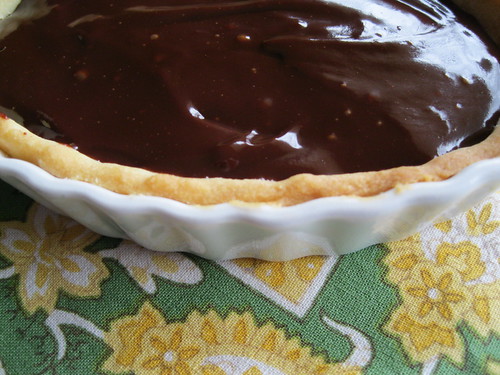 |
| Tart au Chocolat from Paris Sweets by Dorie Greenspan |
But once I tasted a crust made with butter, that made all the difference. Through the pleasures of travel, reading and pastry consumption, I’ve sampled different types of crusts. In French cooking, for instance, there are four basic breeds. Pâte fuilletée is puff pastry. Pâte brisée is your classic all-butter pie crust, perfect for savory or sweet fillings. Pâte sucrée and pâte sablée are for desserts. Both contain sugar, but a pâte sucrée also has whole eggs or egg yolks. It isn’t too far from what we know as a sugar cookie. A pâte sablée is flour, butter, sugar—essentially shortbread dough—pressed into a pie pan. This will be more crumbly, like a shortbread cookie. (A sablé, in fact, is French name for shortbread cookie.)
Pâte sucrée with a bit of ground almonds is used for the tarte au chocolat in this recipe. Both are from Dorie Greenspan’s book Paris Sweets, a collection of recipes she coaxed from venerable restaurants and patisseries in Paris, some of which I have visited. It’s been my dream to actually cook this entire book instead of drooling over the pages.
I like the slight sweetness of this crust and its sturdiness, a perfect match for, say, a silky dark chocolate ganache.
For me, the challenge of making crusts has been in rolling the dough. It would stick or tear and never attain the vision of beauty I imagined. The secret, I’ve learned, is to chill the dough before you roll it. Dough sticks and tears more easily when the fat is warm. The other helpful trick is to roll the dough between pieces of plastic wrap. It’s much less likely to tear when you transfer it to the pan.
Pâte Sucrée
adapted from Paris Sweets by Dorie Greenspan
makes three 9-in crusts, or a multitude of small ones
2 1/2 sticks unsalted butter, room temperature
1 1/2 c confectioners’ sugar
1/2 c almond meal
1/2 t salt
1/2 t vanilla
2 large eggs, room temperature
3 1/2 c all-purpose flour
In a food processor (or by hand with a wooden spoon), work the butter until it is creamy. Add the sugar and process. Then add ground almonds, salt and vanilla, and mix until it is well combined. Mix the eggs in a separate bowl and then add to the other mixture and process. Add flour and pulse just until it all comes together. Grab the dough into a ball and divide into three pieces, pressing each piece into a disk. Wrap in plastic and send to the refrigerator for a minimum 4-hour rest or longer. (Or you can freeze it for up to one month.)
Butter the tart pan(s) and place on a baking sheet.
Take out a piece of dough and place it on the counter between two sheets of plastic wrap. When the dough is the right size for your pan, remove one piece of the plastic wrap and place this side into your pan. Press the dough into the bottom of the pan first, and then work your way up the sides, being careful not to stretch the dough because it will shrink after baking. Lay it in there and give it plenty of room. Now, take your rolling pin and run it along the top of the crust to remove the excess dough. Any empty spots can be repaired with the extra dough. Put this in the refrigerator for 30 minutes to rest.
Preheat the oven to 350 degrees. Line the crust with parchment paper or foil. Fill this with dried beans. Bake for 20-25 minutes, or until the crust starts to get some color. If you need a fully baked crust, then remove the parchment and beans before baking until it is nicely golden. Remove from the oven and cool on a rack. Once cooled, the crust is ready to fill.
More recipes for sweet tart dough:
Pierre Herme's Sweet Tart Dough from Chubby Hubby
Pate Sucrée from The Domestic Goddess
Pate Sucrée from We Are Not Martha
No comments:
Post a Comment
Thank you for visiting my site. Please leave a message!
-Lisa